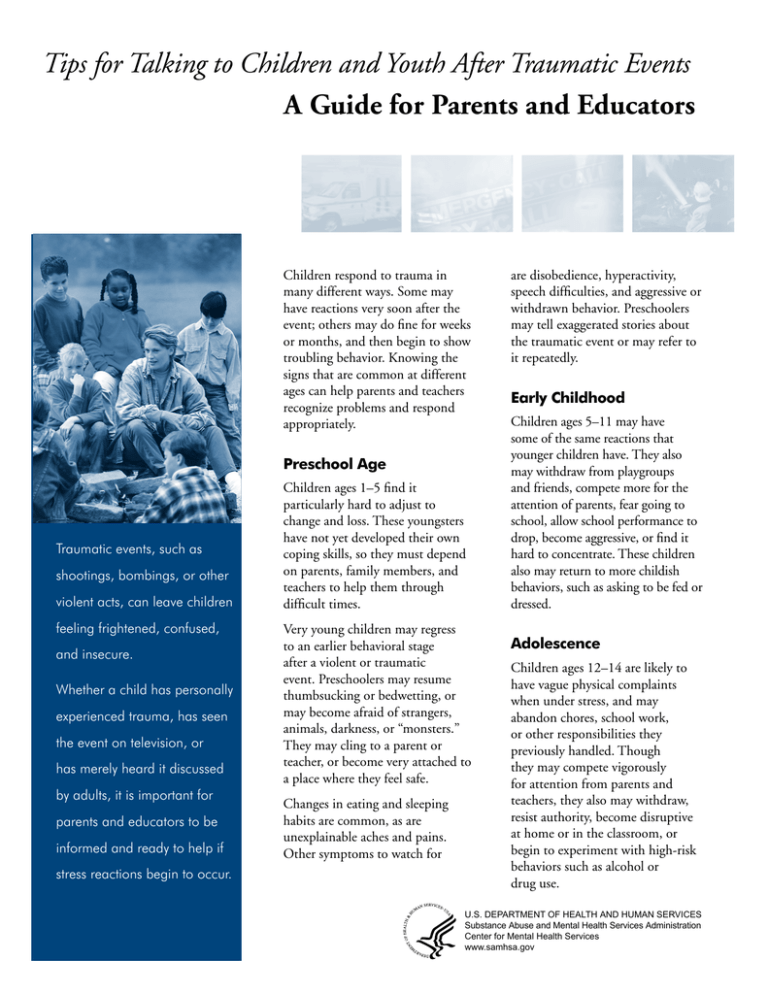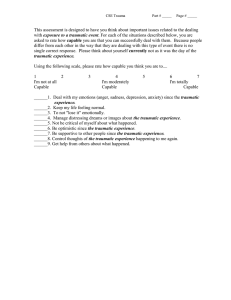A Guide for Parents and Educators
advertisement

Tips for Talking to Children and Youth After Traumatic Events A Guide for Parents and Educators Children respond to trauma in many different ways. Some may have reactions very soon after the event; others may do fine for weeks or months, and then begin to show troubling behavior. Knowing the signs that are common at different ages can help parents and teachers recognize problems and respond appropriately. Preschool Age Traumatic events, such as shootings, bombings, or other violent acts, can leave children feeling frightened, confused, and insecure. Whether a child has personally experienced trauma, has seen the event on television, or has merely heard it discussed by adults, it is important for parents and educators to be informed and ready to help if Children ages 1–5 find it particularly hard to adjust to change and loss. These youngsters have not yet developed their own coping skills, so they must depend on parents, family members, and teachers to help them through difficult times. Very young children may regress to an earlier behavioral stage after a violent or traumatic event. Preschoolers may resume thumbsucking or bedwetting, or may become afraid of strangers, animals, darkness, or “monsters.” They may cling to a parent or teacher, or become very attached to a place where they feel safe. Changes in eating and sleeping habits are common, as are unexplainable aches and pains. Other symptoms to watch for stress reactions begin to occur. · are disobedience, hyperactivity, speech difficulties, and aggressive or withdrawn behavior. Preschoolers may tell exaggerated stories about the traumatic event or may refer to it repeatedly. Early Childhood Children ages 5–11 may have some of the same reactions that younger children have. They also may withdraw from playgroups and friends, compete more for the attention of parents, fear going to school, allow school performance to drop, become aggressive, or find it hard to concentrate. These children also may return to more childish behaviors, such as asking to be fed or dressed. Adolescence Children ages 12–14 are likely to have vague physical complaints when under stress, and may abandon chores, school work, or other responsibilities they previously handled. Though they may compete vigorously for attention from parents and teachers, they also may withdraw, resist authority, become disruptive at home or in the classroom, or begin to experiment with high-risk behaviors such as alcohol or drug use. U.S. DEPARTMENT OF HEALTH AND HUMAN SERVICES Substance Abuse and Mental Health Services Administration Center for Mental Health Services www.samhsa.gov These young people are at a developmental stage in which the opinions of others are very important. They need to be thought of as “normal” by their friends and are less concerned about relating well with adults or participating in family activities they once enjoyed. In later adolescence, teens may experience feelings of helplessness and guilt because they are unable to assume full adult responsibilities as the community responds to the traumatic event. Older teens may deny the extent of their reactions to the traumatic event. How to Help Reassurance is the key to helping children through a traumatic time. Very young children need a lot of cuddling, as well as verbal support. Answer questions about the event honestly, but do not dwell on frightening details or allow the subject to dominate family or classroom time indefinitely. Encourage children of all ages to express emotions through conversation, writing, or artwork and to find a way to help others who were affected by the event. Try to maintain a normal household or classroom routine, and encourage children to participate in recreational activity. Temporarily reduce your expectations about performance in school or at home, perhaps by substituting less demanding responsibilities for normal chores. Acknowledge that you, too, may have reactions associated with the traumatic event, and take steps to promote your own physical and emotional healing. Tips for Talking to Children After a Traumatic Event • Provide children with opportunities to talk about what they are seeing on television and to ask questions. • Do not be afraid to admit that you cannot answer all of their questions. • Answer questions at a level the child can understand. • Provide ongoing opportunities for children to talk. They probably will have more questions as time goes on. • Use this as an opportunity to establish a family emergency plan. Feeling that there is something you can do may be very comforting to both children and adults. • Allow children to discuss other fears and concerns about unrelated issues. This is a good opportunity to explore these issues also. • Monitor children’s television watching. Some parents may wish to limit their child’s exposure to graphic or troubling scenes. To the extent possible, be present when your child is watching news coverage of the event. It is at these times that questions might arise. Helpful Resources National Mental Health Information Center Toll-Free: 1-800-789-2647 (English and Español) TDD: 1-866-889-2647 Web Site: www.mentalhealth.samhsa.gov National Clearinghouse for Alcohol and Drug Information Toll-Free: 1-800-729-6686 (English and Español) TDD: 1-800-487-4889 Web Site: www.ncadi.samhsa.gov Treatment Locators Mental Health Services Locator Toll-Free: 1-800-789-2647 (English and Español) TDD: 1-866-889-2647 Web Site: www.mentalhealth.samhsa.gov/databases Substance Abuse Treatment Facility Locator Toll-Free: 1-800-662-HELP (4357) (24/7 English and Español) TDD: 1-800-487-4889 Web Site: www.findtreatment.samhsa.gov Hotlines National Suicide Prevention Lifeline Toll-Free: 1-800-273-TALK (8255) TTY: 1-800-799-4TTY (4889) Web Site: www.suicidepreventionlifeline.org Office for Victims of Crime Toll-Free: 1-800-851-3420 TTY: 1-877-712-9279 Web Site: www.ojp.usdoj.gov/ovc/ovcres/welcome.html Other Resources National Child Traumatic Stress Network Web Site: www.nctsn.org National Association of School Psychologists Phone: (301) 657-0270 Web Site: www.nasponline.org/NEAT National Center for Children Exposed to Violence Phone: (203) 785-7047 Toll-Free: 1-877-49-NCCEV (496-2238) Fax: (203) 785-4608 Web Site: www.nccev.org/violence/children_terrorism.htm Note: Inclusion of a resource in this fact sheet does not imply endorsement by the Center for Mental Health Services, the Substance Abuse and Mental Health Services Administration, or the U.S. Department of Health and Human Services. KEN–01–0091/KEN–01–0093 Revised 04/07 • Help children understand that there are no bad emotions and that a wide range of reactions is normal. Encourage children to express their feelings to adults (including teachers and parents) who can help them understand their sometimes strong and troubling emotions. • Be careful not to scapegoat or generalize about any particular cultural or ethnic group. Try not to focus on blame. • In addition to the tragic things they see, help children identify good things, such as heroic actions, families who unite and share support, and the assistance offered by people throughout the community. When Talking Isn’t Enough For some children more active interventions may be required, particularly if they were more directly affected by the traumatic event. • The family, as a unit, might consider counseling. Traumatic events often reawaken a child’s fear of loss of parents (frequently a child’s greatest fear) at a time when parents may be preoccupied with their own practical and emotional difficulties. • Families may choose to permit temporary regressive behavior. Several arrangements may help children separate gradually after the agreed-upon time limit: spending extra time with parents immediately before bedtime, leaving the child’s bedroom door slightly ajar, and using a nightlight. • Many parents have their own fears of leaving a child alone after a traumatic event or other fears they may be unable to acknowledge. Parents often are more able to seek help on the children’s behalf and may, in fact, use the children’s problems as a way of asking for help for themselves and other family members. • Teachers also can help children with art and play activities, as well as by encouraging group discussions in the classroom and informational presentations about the traumatic event. Note: Some of the information in this brochure was gathered from a brochure developed by Project Heartland—a project of the Oklahoma Department of Mental Health and Substance Abuse Services in response to the 1995 bombing of the Murrah Federal Building in Oklahoma City. Project Heartland was developed with funds from the Federal Emergency Management Agency in consultation with the Federal Center for Mental Health Services.





